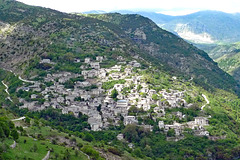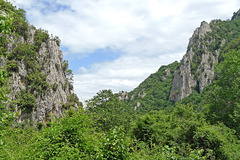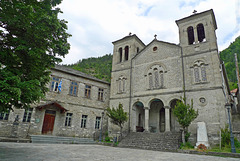
Greece - Ελλάδα - Griekenland
Greece - Syrrako
| |
|
|
|
Syrrako is a beautiful and picturesque village, which impresses with its grey stone houses that are perched on a steep slope of Mount Peristeri on an altitude of 1.200 meters. The ‘fairytale’village – located in the heart of the Tzoumerka region - is declared to be a traditional settlement. The village offers stone houses with slate roofs, cobbled alleys, churches, watermills, stone fountains, which are creations of renowed craftsmen.
Syrrako was built by Greek Vlach speakers in the 15th century. Around the year of 1480 the village along with other villages in the area, went under the Ottoman domination but managed to secure a privileged tax treatment and some kind of autonomy. Syrrako and neighboutring Kalarrytes were the only villages of Epirus that took part in the Greek Revolution from the first years. During that period, the village was looted and burnt down by the Turks and the inhabitants abandoned it, trying to save their lives. They returned in the year 1825 and rebuilt Syrrako.
Greece - Pogoniskos/Boútsikon
| |
|
|
|
On our car journey from Molyvdoskepastos - close to the Albanian border - to Konitsa, we found ourselves on a very narrow road through a pristine stretch of nature. It was impossible to turn around and we had to drive on to the very tiny hamlet of Pogoniskos with just a couple of inhabitants. That had the advantage of taking us past a countless number of 'carpets' of wild flowers in all sorts of colours and shapes (see PiPs). The valley was enclosed by rugged cliffs.
Greece - Pyrsogianni, Church of St George
| |
|
|
|
The new Church of St George was built in 1903-1905, after the old church - dating back to the year of 1712 -with the same name was demolished. Although rather ‘young’ the church has a beautiful interior with remarkable pillars, some chandeliers and a woodcarved iconostase.
The Church of St. George was built according to the standards of the Cathedral of Athens, with voluntary work of craftsmen of the village, while the basic cost of the construction was covered by the contributions of people coming from Pyrsogianni from all over the world.
Greece - Samos, Pythagorion
| |
|
|
|
Pythagorion is one the most picturesque villages on the island of Samos. It is named after the famous philosopher and scientist Pythagoras. Pythagorion has a beautiful port where many beautiful old sailing ships, fishing boats and ferries to other islands moor. This harbour is maybe one of the oldest ports in the Mediterranean sea.
The town with its traditional old houses with red-tiled roofs is built amphitheatrically around the bay, where the ancient town of the island was found during excavations..
Greece - Monodendri, stone forest
| |
|
|
|
The stone forest nearby Monodendri is one of the most remarkablke places in Greece. Layers of natural rock formations shaped like trees at an altitude of 1.500 meters. Geomorphs that resulted from the disintregation and erosion of limestone in an alpine environment, located in a normal forest of oaks and maples. It took thousands and thousands of years to cause this erosion and disintregation of the slabs. Nowadays these towering limestone formations create a real natural ‘artwork’.
Greece - Nauplion, Agia Moni
| |
|
|
|
The nunnery of Agia Moni is located a couple of kilometers outside the town of Nafplion. The katholikon (= main church) is dating back to the middle of the 12th century. It is one of the most important churches of the middle Byzantine period in Greece. According to its foundation inscription the church was built with donations of the bishop of Argos and Nafplion, who had constructed it in the year of 1149.
The church is mainly of architectural interest as the murals and decorations have not survived. Apart from the church, the monastery complex consists of small chapels and housing and living quarters for the nuns, who still life here. The church is dedicated to Zoodochos (= “Source of life”). Just outside the nunnery one can find the monastic spring, which is famous for its water.
Greece - Patmos
| |
|
|
|
Patmos is inhabited since 3000 BC, but the identity of its first inhabitants is still unknown. Finds have excavated various buildings, cemeteries, fortresses, and evidence of an ancient acropolis, testifying the existence of a densely populated area in the past.
Patmos declined when the Romans conquered it. It was used as a place of exile for convicts. This is how Apostle John came to Patmos. He conveyed the inhabitants to Christianity and wrote the Book of Revelation, the Apocalypse. Patmos then became a place of worshipping and pilgrimage and actually.
During the Byzantine times, the inhabitants of Patmos built a Grand Royal Basilica in honor of Saint John. During the Arab raids from the 6th to the 9th century the basilica was destroyed. In 1101 the construction of the Monastery of Saint John the Theologian started. The fame of the monastery grew and a settlement started to expend around it. During the end of the 12th century, the island of Patmos was transformed into a large commercial center.
In 1522, the Turks came to the island; after a while, they left the island, which they just forced to pay some taxes. When the Turkish-Venetian Wars ended, tranquillity returned to Patmos and the island flourished, becoming once again an important commercial center. Massive fortifications were built around the monastery as a protection from the pirates. In 1655, Patmos was governed by the monks and prospered again. Its growth stopped in 1659, when the Venetians, conquered and destroyed the island of Patmos. With shipping, commerce and the efforts of the inhabitants, Patmos regained its lost nobility, glamour and prosperity.
The Russians conquered the island in 1770, after the Turkish-Venetian War. The Greek Revolution started in 1821 and managed to gain the independence of Greece in 1832. The treaty signed in London did not include the islands of the Dodecanese as part of the newly built Greek State and therefore fell again under Turkish occupation.
The Italians occupied all the islands of the Dodecanese in 1912, with of course Patmos, and remained there until 1943, when the Germans took over the island. In 1945, the Germans left and the island of Patmos remained autonomous until 1948 when it joined the rest of independent Greece with the rest of the Dodecanese Islands.
In 1981, Greece declared Patmos a “Sacred Island'', and in 1999 UNESCO included The Historic Centre (Chora) with the Monastery of Saint John the Theologian and the Cave of the Apocalypse in its World Heritage Site List. Patmos is also part of the COESIMA network, as one of the seven most important pilgrimage sites in Europe.
Greece - Patmos, Monastery of Saint John the Theol…
| |
|
|
|
In 1088 in Patmos, St. Christodoulos the Latrinos (a gifted and educated monk) was granted funds by the Byzantine Emperor Alexios I Komnenos, to establish a monastery in honor of Saint John the Theologian. In 1091, Christodoulos began the construction of the monastery over the ruins of a 4th-century basilica, also dedicated to Saint John.
The Monastery of Saint John the Theologian, built on top of Chora, dominates the whole island and looks like a Byzantine castle. It is surrounded by an irregular rectangular defensive enclosure, dating from the late 11th century until the 17th. Among other buildings the katholikon and cells have been preserved since the Byzantine period. The monastery’s walls are over 15 meters high, its length from north to south is 53 meters and from east to west 70 meters.
The library of the monastery and the rich collection of relics is considered really famous, the most important examples of which can be admired in the sacristy.
In 1999, the Monastery of Saint John the Theologian was declared a “World Heritage Monument” by UNESCO, along with the Holy Cave of the Apocalypse.
As my wife's ancestors lived on Patmos in the 18th century, we have visited the island a couple of times. Since we have an original letter from one of the abbots, we also visited the monastery, hoping for additional information. Unfortunately, nothing was found there at such short notice.
Jump to top
RSS feed- Latest items - Subscribe to the latest items added to this album
- ipernity © 2007-2024
- Help & Contact
|
Club news
|
About ipernity
|
History |
ipernity Club & Prices |
Guide of good conduct
Donate | Group guidelines | Privacy policy | Terms of use | Statutes | In memoria -
Facebook
Twitter








